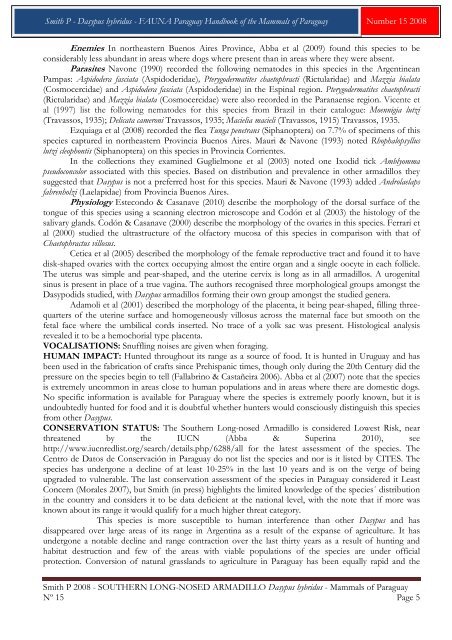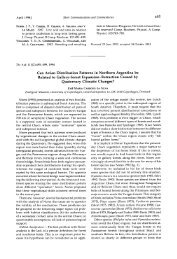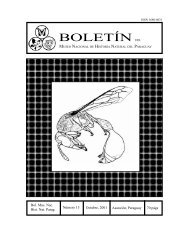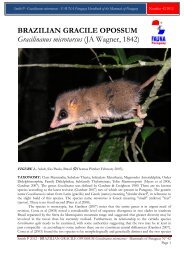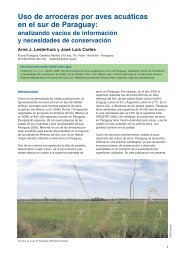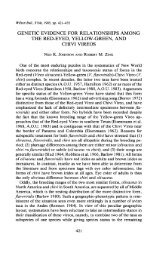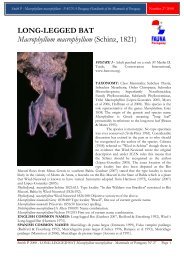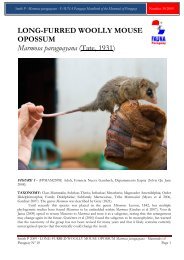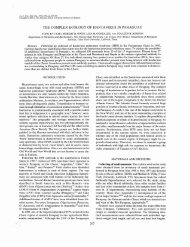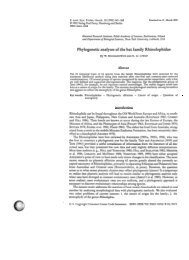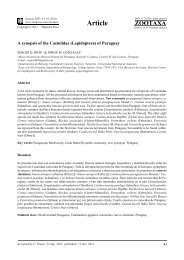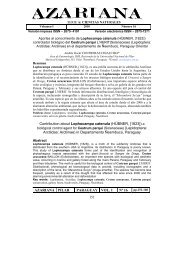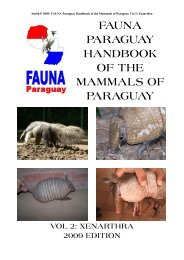Create successful ePaper yourself
Turn your PDF publications into a flip-book with our unique Google optimized e-Paper software.
<strong>Smith</strong> P - Dasypus hybridus - <strong>FAUNA</strong> <strong>Paraguay</strong> Handbook of the Mammals of <strong>Paraguay</strong> Number 15 <strong>2008</strong><br />
Enemies In northeastern Buenos Aires Province, Abba et al (2009) found this species to be<br />
considerably less abundant in areas where dogs where present than in areas where they were absent.<br />
Parasites Navone (1990) recorded the following nematodes in this species in the Argentinean<br />
Pampas: Aspidodera fasciata (Aspidoderidae), Pterygodermatites chaetophracti (Rictularidae) and Mazzia bialata<br />
(Cosmocercidae) and Aspidodera fasciata (Aspidoderidae) in the Espinal region. Pterygodermatites chaetophracti<br />
(Rictularidae) and Mazzia bialata (Cosmocercidae) were also recorded in the Paranaense region. Vicente et<br />
al (1997) list the following nematodes for this species from Brazil in their catalogue: Moennigia lutzi<br />
(Travassos, 1935); Delicata cameroni Travassos, 1935; Macielia macieli (Travassos, 1915) Travassos, 1935.<br />
Ezquiaga et al (<strong>2008</strong>) recorded the flea Tunga penetrans (Siphanoptera) on 7.7% of specimens of this<br />
species captured in northeastern Provincia Buenos Aires. Mauri & Navone (1993) noted Rhophalopsyllus<br />
lutzi cleophontis (Siphanoptera) on this species in Provincia Corrientes.<br />
In the collections they examined Guglielmone et al (2003) noted one Ixodid tick Amblyomma<br />
pseudoconcolor associated with this species. Based on distribution and prevalence in other armadillos they<br />
suggested that Dasypus is not a preferred host for this species. Mauri & Navone (1993) added Androlaelaps<br />
fahrenholzi (Laelapidae) from Provincia Buenos Aires.<br />
Physiology Estecondo & Casanave (2010) describe the morphology of the dorsal surface of the<br />
tongue of this species using a scanning electron microscope and Codón et al (2003) the histology of the<br />
salivary glands. Codón & Casanave (2000) describe the morphology of the ovaries in this species. Ferrari et<br />
al (2000) studied the ultrastructure of the olfactory mucosa of this species in comparison with that of<br />
Chaetophractus villosus.<br />
Cetica et al (2005) described the morphology of the female reproductive tract and found it to have<br />
disk-shaped ovaries with the cortex occupying almost the entire organ and a single oocyte in each follicle.<br />
The uterus was simple and pear-shaped, and the uterine cervix is long as in all armadillos. A urogenital<br />
sinus is present in place of a true vagina. The authors recognised three morphological groups amongst the<br />
Dasypodids studied, with Dasypus armadillos forming their own group amongst the studied genera.<br />
Adamoli et al (2001) described the morphology of the placenta, it being pear-shaped, filling threequarters<br />
of the uterine surface and homogeneously villosus across the maternal face but smooth on the<br />
fetal face where the umbilical cords inserted. No trace of a yolk sac was present. Histological analysis<br />
revealed it to be a hemochorial type placenta.<br />
VOCALISATIONS: Snuffling noises are given when foraging.<br />
HUMAN IMPACT: Hunted throughout its range as a source of food. It is hunted in Uruguay and has<br />
been used in the fabrication of crafts since Prehispanic times, though only during the 20th Century did the<br />
pressure on the species begin to tell (Fallabrino & Castañeira 2006). Abba et al (2007) note that the species<br />
is extremely uncommon in areas close to human populations and in areas where there are domestic dogs.<br />
No specific information is available for <strong>Paraguay</strong> where the species is extremely poorly known, but it is<br />
undoubtedly hunted for food and it is doubtful whether hunters would consciously distinguish this species<br />
from other Dasypus.<br />
CONSERVATION STATUS: The Southern Long-nosed Armadillo is considered Lowest Risk, near<br />
threatened by the IUCN (Abba & Superina 2010), see<br />
http://www.iucnredlist.org/search/details.php/6288/all for the latest assessment of the species. The<br />
Centro de Datos de Conservación in <strong>Paraguay</strong> do not list the species and nor is it listed by CITES. The<br />
species has undergone a decline of at least 10-25% in the last 10 years and is on the verge of being<br />
upgraded to vulnerable. The last conservation assessment of the species in <strong>Paraguay</strong> considered it Least<br />
Concern (Morales 2007), but <strong>Smith</strong> (in press) highlights the limited knowledge of the species´ distribution<br />
in the country and considers it to be data deficient at the national level, with the note that if more was<br />
known about its range it would qualify for a much higher threat category.<br />
This species is more susceptible to human interference than other Dasypus and has<br />
disappeared over large areas of its range in Argentina as a result of the expanse of agriculture. It has<br />
undergone a notable decline and range contraction over the last thirty years as a result of hunting and<br />
habitat destruction and few of the areas with viable populations of the species are under official<br />
protection. Conversion of natural grasslands to agriculture in <strong>Paraguay</strong> has been equally rapid and the<br />
<strong>Smith</strong> P <strong>2008</strong> - SOUTHERN LONG-NOSED ARMADILLO Dasypus hybridus - Mammals of <strong>Paraguay</strong><br />
Nº 15 Page 5


